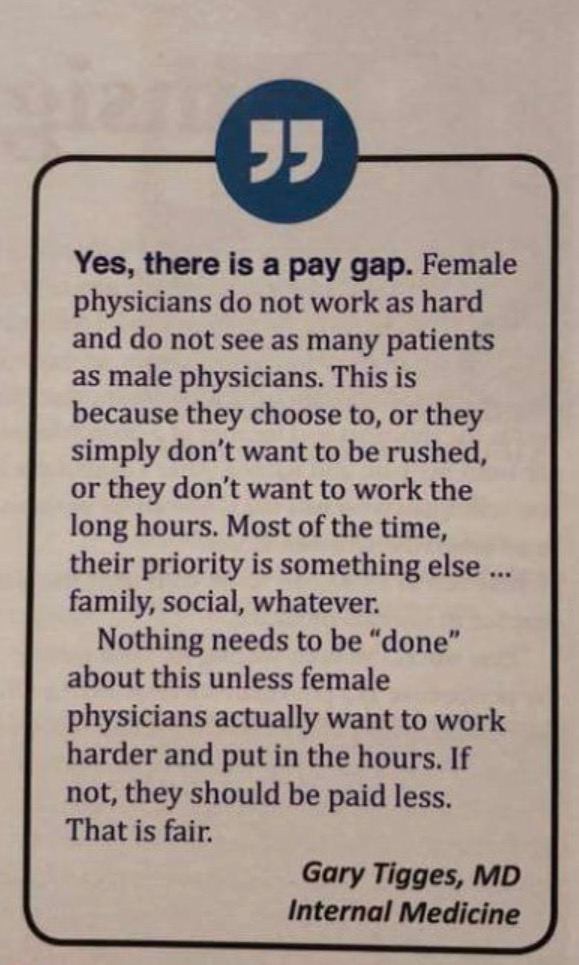A male physician in Texas, Gary Tigges, MD, faced a rude awakening when comments he believed would remain private about the proven, existing gender pay gap between male and female physicians, that he purports is justified, were published in the Dallas Medical Journal.
Thereafter, things have not gone well for him.
Social media was ignited. The expected onslaught ensued with calls for patients not to go to him for care to mockery of his character and utter outrage (just hashtag his name for the endless litany). His anticipated, reflexive but seemingly self-serving apology fell short as he grasped for the du jour “out of context” claims and ignorance to the public nature of his response to a survey of the medical society’s 7500 members on the subject (for which the organization maintains participants knew the “best” reply could appear in the September issue). Given his history of leadership positions, the damage was done and the old non-apology apology was unlikely to move any needle.
I would actually like to thank Dr. Tigges. And the Dallas Medical Journal who distanced themselves from the substance of his remarks, but defended their reasons for publishing them. They were right to do so. Unless we have actually honest dialogue about the topic, there will be no progress. Dr. Tigges' misguided statements, out of step with more than a decade of data that disputes his biased assertions demonstrating that female physicians are not only as good as their male counterparts but in many instances provide higher quality care with better outcomes, are commonly held beliefs throughout the healthcare system, particularly by those in management and administrative roles (see here and here). They are insidious notions that are pervasive throughout disciplines and lead to greater societal costs.
Given his amplified voice due to his prominent posts in leadership and having been the likely arbiter of staff remuneration (based on his website, internet searches and relevant reporting), his views are sadly but a dime a dozen in the field and translate into much inequitable action. Such a reality prompted the two-page feature to begin with, as it “addressed a report indicating that female doctors' salaries amounted to about two-thirds that of their male counterparts.”
So, what did he say?
In a section ironically entitled “Big and Bright Ideas,” Dr. Tigges correctly acknowledges "Yes, there is a pay gap" and continues to write "Female physicians do not work as hard and do not see as many patients as male physicians. This is because they choose to, or they simply don't want to be rushed, or they don't work the long hours. Most of the time, their priority is something else... family, social, whatever." He concludes, "Nothing needs to be 'done' about this unless female physicians actually want to work harder and put in the hours. If not, they should be paid less. That is fair."

Now what
We know there is a gender pay gap in medicine. It’s time to move beyond the question of whether it exists and onto how to eliminate such discriminatory reasoning and optimize the entire work force’s potential. Everyone wins in the end.
Though Dr. Tigges has become a symbolic viral sensation, he is not alone in his misguided views and rationalizations as to why such pay gaps exist. For one, the remaining opinions expressed in the Dallas Medical Journal’s spread had some problematic, faulty perspectives as well. These reflect a mere snippet of the rampant impact of gender discrimination in the field.
The subject, like most, requires nuance in understanding the complexities. Different disciplines in medicine experience different degrees and areas of inequity - what goes on in neurosurgery is distinct from pediatrics, the same is true for whether you work for a hospital or are employed by or run a practice. In hospitals, for instance, I touch upon the perverse payment incentives of the RVU (relative value unit) system here which values low quality, high volume patient mill type medical practice. The euphemism of the metric being indicative of “productivity,” I would challenge for debate. It contributes to much suffering, unnecessary testing, medical error, negative chain reactions, bad outcomes and greater overall costs. Not every physician is paid by this type of system, outside of the hospital or when salaried someone might be reimbursed for time and get short-changed for seeing many patients, for example.
Another example that is standard fare for those subscribing to the Tigges way of thinking is that more women physicians work part-time. The reasons for this are often mischaracterized as "their choice." This is often not the case. Practices don't have to cover benefits or pay as much for part-time, so they offer it instead which uniformly results in full-time work for part-time pay. Changing jobs or accepting the reality of seeing more for less until something better comes is a mainstay dilemma for countless women.
Appreciating the complicating factors doesn’t change the fact whether a woman is single and the sole breadwinner, divorced or married with or without children, discrimination abounds regardless of whether she delivers the same or even better care than her male counterparts and works endless hours ("30% of physician women have experienced sexual harassment and 73% have experienced gender discrimination in the workplace"). The price of such cumulative, exhausting undervaluing of a substantial component of the workforce in medicine is substantial, not only in existential terms for our culture, but also in tangible monetary ones - leading to burnout, leaving the profession and high rates of attrition.
According to data and analytics from Equity Quotient
-
Of 446 major U.S. occupations, physicians have largest median gender-based pay gaps; in some subspecialties, as much as $90k (Wall Street Journal 2016)
-
Over $9,000 per physician/per year is spent by healthcare organizations due to gender inequality — cost accrued from attrition, burnout and litigation (discrimination/sexual harassment).
-
Total cost of recruitment, on-boarding, lost revenue, about $400k (up to $600k) for a single hospitalist
Opening the minds or hearts of those who think like Dr. Tigges is important. After all, very few males were a part of the social media reaction to this occurrence. If they were, then it was more to point out the "he really stepped into it" refrain than any commentary on the substance of his remarks. The public silence from male physicians has been deafening which is probably of greatest significance, so I continue to be appreciative of the entire situation. Knowing where you stand is the first step to any progress. But, in the end, even if it isn’t possible to change perceptions and the worthy efforts clearly require steep hills to climb, allowing those in positions of power to act on such erroneous beliefs and miscalculations simply makes bad business sense.

